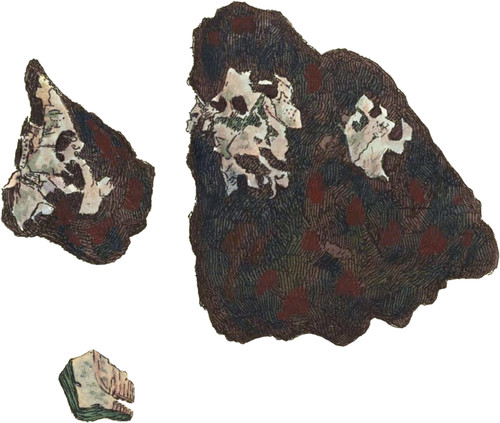 Enlarge
Enlarge
British Mineralogy
Schiller Stone
- Syn.
- Schiller Spath. Emmerl. 3. 340.
- Spath chatoyant des Allemands. Haüy, 4. 395.
- Schiller Stone. Jameson, 1. 428.
Already mentioned at tab. 221. This substance is not much known, and although tolerably easily detected when in Serpentine, is not otherwise much unlike some sorts of Hornblende; it is, however, much softer, and is rather easily scratched with a knife, giving a white streak somewhat metallic in lustre, and having a plated appearance. In the British specimens, either from Cornwall or Scotland, the plated structure is more or less readily seen in numerous brilliant specks, from the tenth of an inch to upwards of half an inch in size: the larger plates have frequently a broken or ragged appearance, with holes in them penetrated by the duller Serpentine, or its flat surface forming round about the rugged earth, which often accompanies the dark brick-coloured Serpentine.
The plates seem very thin, and accumulated upon each other; and this is partly seen in some rhombic sides, resembling some slaty structures: on the other sides it is not at all discernible. The substance on the whole is of a dull blueish green, or middle greenish grey—see my Elucidation of Colours, tab. 5 and 6, No. 47*. The plated faces reflect yellowish and reddish illinitions, probably from the position and colour of the matrix. Its peculiar glance is pretty well represented when we see the whitish shining appearance of the print. The substance itself is chiefly recognizable by this glare. On Charcoal with a blowpipe it melts into a black enamel, difficultly when compact, but more easily when in a looser and rather decomposed state, when it is generally of a reddish hue. It has often been taken for Hornblende; it looks very like some Feldspar in its peculiar lustre; and I have seen Carbonate of Lime somewhat resembling it, in the coarser crystallized masses of rocks.
Mr. Hatchett is said to have first observed it in the Serpentine of Cornwall; and I have received specimens from my kind friend Philip Rashleigh, Esq.; and this month I received a specimen gathered by Mr. Jackson in Montrose, Scotland.
- * It is usually called Olive green; but olives differ very much. I feel confident that a table for colours and reference will be most exact

